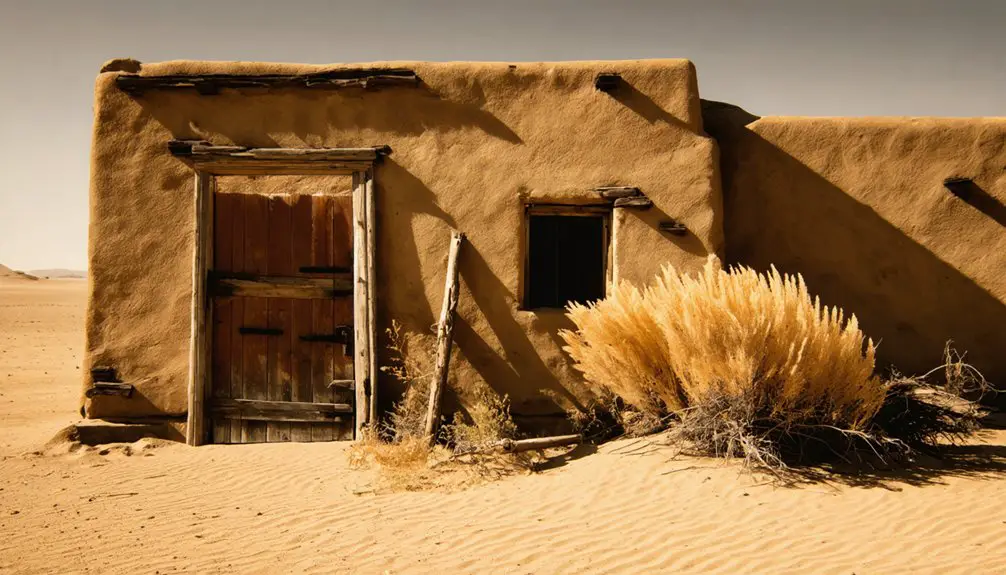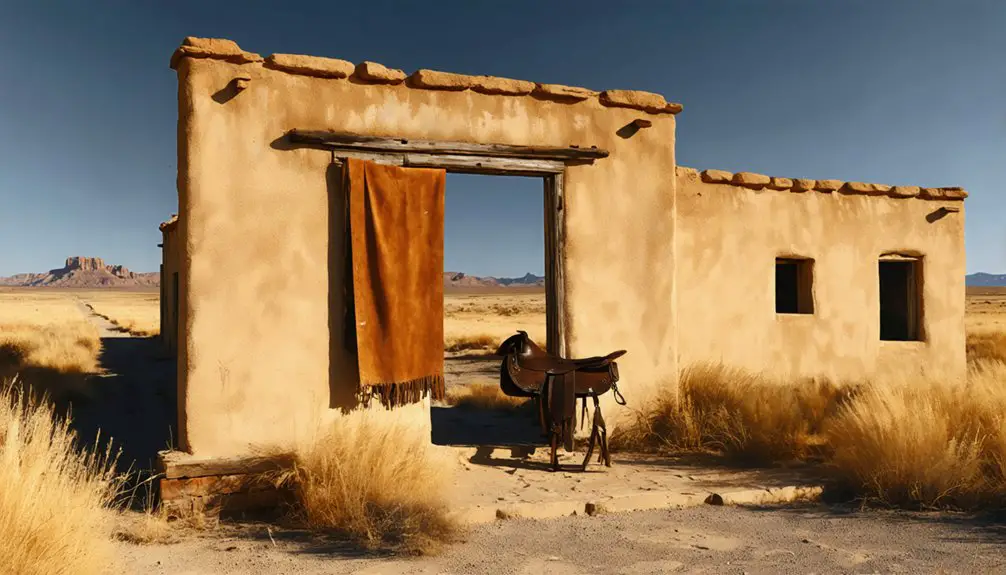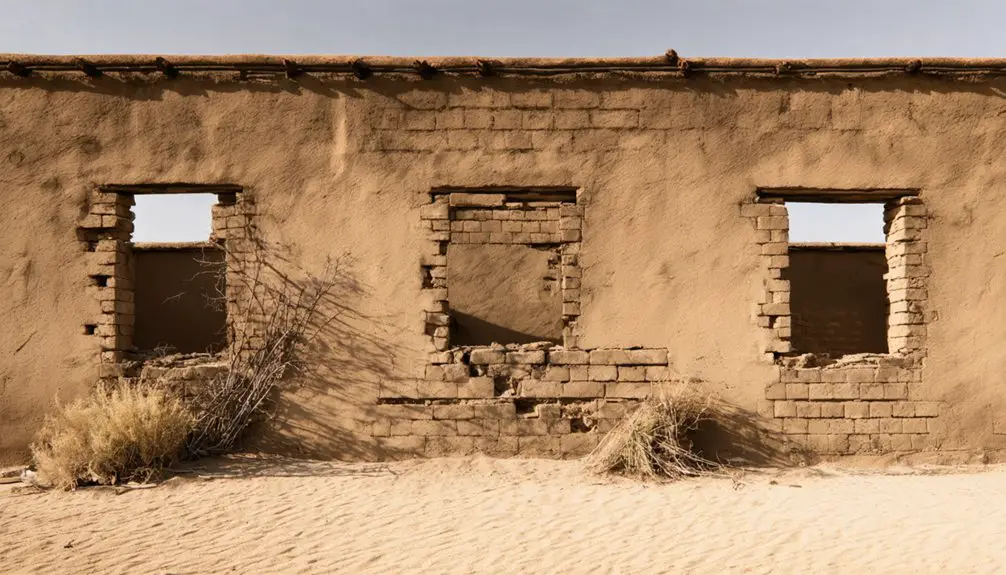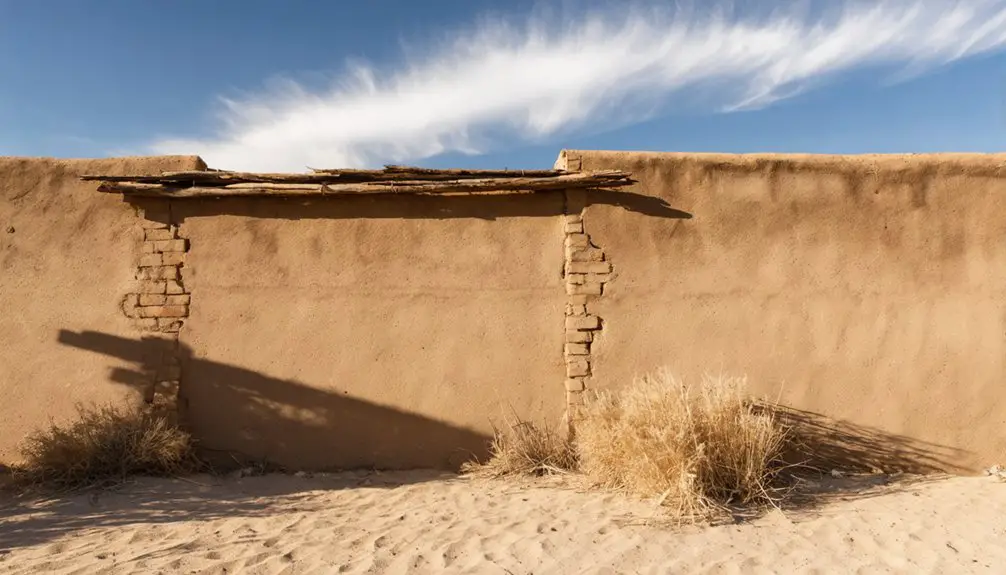You’ll find Adobe Walls in Hutchinson County, Texas, where a once-bustling buffalo trading post from 1843 now stands silent. This historic site witnessed two major frontier battles: the first in 1864 with Kit Carson’s troops against Native American warriors, and the second in 1874 featuring Billy Dixon’s legendary long-distance shot. Today, while private ranchland restricts access, you can still spot the original trading post foundations and Billy Dixon’s grave, where visitors leave coins and cartridges to honor his memory.
Key Takeaways
- Adobe Walls is a Texas ghost town established in 1843 as a trading post during the buffalo hide trade era.
- The site witnessed two major battles between Native Americans and settlers in 1864 and 1874.
- Archaeological excavations revealed foundations of original trading posts and artifacts from frontier life and historic battles.
- The location is now private ranchland with limited public access, marked by pipe fences indicating historic battle positions.
- Billy Dixon’s grave remains a significant landmark where visitors leave coins and cartridges as tributes.
The Birth of a Trading Post
In the heart of Comanchería, the first Adobe Walls trading post emerged in 1843 when Bent, St. Vrain and Company established their frontier outpost.
You’ll find it wasn’t just another trading station – it quickly became a significant landmark for both Native American tribes and Comancheros who traversed these contested lands.
The trading post’s economic significance extended beyond mere commerce. Initial structures consisted of tepees and logs before the permanent fort was constructed.
Adobe Walls stood as a vital economic nexus, fostering cultural exchange and shaping the frontier’s complex commercial networks.
The site would later prove a lucrative spot for hunters who could earn over 100 dollars daily from buffalo hides.
You’re looking at a strategic rest stop that served military expeditions, including Kit Carson’s 1864 campaign.
The adobe structure’s protective walls offered shelter in this wild territory, while its position made it an ideal hub for trade.
Even after the original post’s decline, its ruins remained important enough to attract buffalo hunters and merchants who’d establish a new commercial center there in the 1870s.
Tales From the First Battle
When Colonel Kit Carson led his 336 cavalry troops and 75 Indian scouts to Adobe Walls on November 25, 1864, he couldn’t have anticipated the massive force that awaited him.
You’d have witnessed up to 3,000 Kiowa, Comanche, and Plains Apache warriors converging on his position, their warrior tactics including painted bodies and strategic bugle calls led by the cunning Chief Satanta.
The battle’s historical significance unfolds as you picture Carson’s men fortifying the ruins and positioning two essential howitzers.
While brave leaders like Chief Iron Shirt fought to the death, others like Dohäsan coordinated fierce attacks.
Though outnumbered, Carson’s forces held their ground until ammunition ran low. As supplies dwindled, Carson made the critical choice to destroy the village and withdraw his troops.
Fierce snowstorms and harsh weather had slowed their progress leading up to this decisive battle.
The Second Battle’s Turning Point
At Adobe Walls, you’ll find the dramatic turning point of the Second Battle centered on Billy Dixon’s legendary shot that struck a warrior from nearly a mile away on a distant mesa.
The shot’s impact resonated far beyond its physical effect, shattering the Plains warriors’ confidence and disrupting their war council. The warriors were led by Quanah Parker and Isa-tai, who had initially rallied their forces for the dawn attack.
Your visit to this historic site recalls how this singular demonstration of marksmanship helped twenty-eight buffalo hunters withstand an overwhelming force of 700 Native American warriors. The battle began in darkness when pre-dawn attackers attempted to breach the camp’s defenses through close-quarters combat.
Dixon’s Legendary Shot
The most celebrated moment of the Second Battle of Adobe Walls came on June 28, 1874, when buffalo hunter Billy Dixon made what would become known as one of the most extraordinary rifle shots in frontier history.
From within the stockade’s walls, Dixon spotted a Cheyenne warrior perched on a distant mesa roughly 7/8 of a mile away. Using his prized Sharps rifle, he took aim and fired. Dixon’s accuracy proved lethal, with the shot striking its target at an astounding 1,538 yards.
The historical significance of this shot extended far beyond mere marksmanship. It prevented the Indians from using the mesa as an observation point, boosted defender morale, and helped turn the tide of the battle. This event occurred during a fierce conflict between 28 buffalo hunters and approximately 700 Comanche warriors.
Though Dixon himself credited luck over skill, his shot became a defining moment in the defense of Adobe Walls. Dixon had developed his marksmanship by shooting at rocks from a nearby outcropping for target practice.
Warriors Council Disrupted
Prior to the Second Battle of Adobe Walls, a powerful alliance formed among Comanche, Kiowa, and Cheyenne warriors, inspired by the charismatic medicine man Isa-tai’s prophecies of invulnerability.
You’ll find that this unified force of 700 warriors, led by Quanah Parker, initially moved with singular purpose against the buffalo hunters’ camp.
But as the battle unfolded, you’d witness how Isa-tai’s prophecy impact crumbled under the hunters’ deadly accurate fire.
The trading post residents suffered four hunter casualties during the intense early morning assault.
When warriors realized bullets could indeed harm them, deep warrior divisions emerged. Despite Parker’s attempts to maintain cohesion, the failed prophecy shattered the council’s unity.
The warriors’ confidence was further shaken when Billy Dixon made his legendary shot from a mile away, demonstrating the hunters’ superior firepower.
What began as a coordinated assault devolved into a disjointed siege, with many warriors losing faith and withdrawing from the fight altogether.
Life on the Texas Frontier
Living on Texas’s western frontier demanded remarkable adaptations from settlers who faced harsh, arid conditions unlike anything they’d known back East. You’d find yourself maneuvering through frontier hardships daily, from performing backbreaking farm labor to defending your homestead.
Cultural adaptations became essential as Anglo settlers, Native Americans, and Mexican residents sought ways to coexist in this challenging environment.
Your daily routine would have included:
- Self-reliant tasks like farming, animal care, and food preservation without modern conveniences
- Operating under various legal systems, from Mexican law to Republic of Texas regulations
- Maintaining Victorian ideals while adapting to primitive conditions, especially in military settlements
You’d need to master both farming and ranching skills, while carefully managing water resources and dealing with frequent illnesses in an era of rudimentary medical care.
Kit Carson’s Strategic Retreat

While frontier settlers struggled to establish their homesteads, military leaders faced their own challenges in maintaining order across the vast Texas territory.
You’ll find that Kit Carson’s leadership at Adobe Walls in 1864 proved vital during a confrontation with combined Comanche, Kiowa, and Apache forces. When his scouts warned of overwhelming enemy numbers, Carson’s tactical decisions favored prudence over aggression. Rather than following his officers’ calls for direct assault, he ordered a strategic night retreat from the old trading post ruins.
Despite losing 176 enemy lodges and inflicting up to 150 casualties on native forces, Carson’s withdrawal preserved his volunteer regiment, suffering only three deaths and twenty-five wounded.
General Carleton later praised this measured response, though the inability to secure reinforcements left the region vulnerable to continued raids.
Quanah Parker’s Last Stand
As tensions escalated across the Texas frontier in 1874, Quanah Parker led a force of several hundred Comanche, Kiowa, and Cheyenne warriors in an attack on Adobe Walls trading post.
Under his fierce Comanche leadership, the assault marked a desperate fight to protect their way of life from encroaching buffalo hunters.
You’ll find the dramatic events unfolded in three key phases:
- Parker’s warriors launched their initial attack at dawn, catching the buffalo hunters by surprise.
- The hunters managed to hold off the assault from their fortified trading post positions.
- After several days of fighting, Parker withdrew his forces when it became clear they couldn’t overcome the defenders’ long-range weapons.
This battle represented one of Parker’s final acts of armed resistance before ultimately surrendering in 1875.
The Legacy of Billy Dixon

The rugged frontier spirit of Billy Dixon shaped the destiny of Adobe Walls and the Texas Panhandle throughout the 1870s.
You’ll find his legacy deeply woven into the region’s transformation, from his early days as a successful buffalo hunter who employed ten skinners during peak seasons to his heroic defense of Adobe Walls against 700 Native American warriors.
Dixon’s exploits didn’t end with buffalo hunting – he earned the Medal of Honor for his bravery in the Buffalo Wallow Fight while serving as a scout for General Miles.
After settling near the original Adobe Walls site in 1883, he cultivated the land that had once been his hunting ground.
His connection to this historic place endures as a powerful symbol of the frontier era’s end and the changing American West.
Preserving a Historical Landmark
Recent archaeological work in Adobes’ Sacred Heart of Jesus Catholic Church has uncovered artifacts that reveal patterns of early Anglo and Hispanic settlement along the Chihuahua Trail.
You’ll find preservation teams actively working to stabilize the church’s adobe walls and restore its historic steeple through partnerships between local nonprofits and the El Paso Catholic Diocese.
Your visit to this landmark showcases the community’s dedication to protecting their heritage, as monthly masses continue while restoration efforts balance structural safety with maintaining the site’s authentic ghost town character.
Archaeological Discoveries Revealed
Major archaeological discoveries at Adobe Walls have revealed fascinating details about this historic Texas trading post and battleground since its designation as a state archaeological landmark in 1979.
Through meticulous archaeological methods, researchers have unearthed remarkable structures and artifact significance that paint a vivid picture of frontier life and conflict.
You’ll find these key discoveries particularly compelling:
- Sun-dried adobe bricks measuring 10 x 9 x 23 cm were found 53 cm below ground, showing construction techniques similar to those used at the Alamo.
- Battle-related artifacts, including weapon fragments and bullets, confirm historical accounts of the 700-strong Indian attack.
- Foundation remains of trading posts and ranching buildings near the Canadian River reveal the site’s importance as a frontier commercial hub.
Landmark Protection Efforts
Since gaining federal recognition on the National Register of Historic Places in 1978, Adobe Walls has benefited from multiple layers of protection aimed at preserving its historical legacy. A year later, its landmark significance grew when Texas designated it as a state archaeological landmark, strengthening legal safeguards against development.
Despite these protections, you’ll find preservation challenges persist. Private landowners have restricted site access, while harsh weather and erosion threaten the adobe structures.
The Panhandle-Plains Historical Society, which acquired the battle site in 1923, conducted essential excavations in the 1970s to document and stabilize the trading post remains.
Today, nonprofit organizations propose converting such historic sites into living history destinations, though they must balance public access with protection from vandalism and environmental threats.
Community Heritage Impact
The preservation of Adobes, Texas carries profound significance for both regional identity and historical understanding.
You’ll find that this ghost town’s heritage continues to shape community pride through its tangible connections to frontier life, buffalo hunting, and indigenous relations.
The site’s impact on cultural education and local identity manifests in:
- Physical ruins that showcase 19th-century construction techniques and frontier living
- Agricultural traditions spanning 750 irrigated acres by 1930, representing regional farming evolution
- Educational tourism opportunities that connect visitors with authentic Texas frontier experiences
You’re witnessing a living reflection of the Madrid family’s legacy and other settlers who shaped this land.
Their stories, preserved through architectural remains and historical interpretation, offer invaluable insights into the transformation of the Texas Panhandle region.
Archaeological Discoveries
Archaeological excavations in the 1970s revealed fascinating details about Adobe Walls’ trading post era, uncovering foundations and artifacts from the 1874 settlement that was burned and abandoned.
Through careful archaeological methods, researchers mapped the layout of stores, a saloon, and a blacksmith shop that once formed this frontier trading hub. Excavation techniques exposed evidence of both the 1864 and 1874 battles, including weapons, cartridges, and personal items from settlers and Native Americans alike.
You’ll find the site’s archaeological significance preserved through state protection since 1941, with no modern additions disturbing its integrity.
Multiple graves, including Billy Dixon’s, have been identified and fenced. The excavated ruins tell a compelling story of cultural exchange, territorial conflict, and the dramatic clash between Native Americans defending their hunting grounds and westward expansion.
The Ghost Town Today

While Adobe Walls‘ original trading post and battle sites now lie on private Turkey Track Ranch land with restricted access, you’ll find the area’s historic significance preserved primarily through offsite museums and markers rather than direct visitation.
You can spot remnants of the old settlement’s history through glimpses of cattle guards and warning signs that now mark the approaches to this once-bustling frontier trading post.
Though the site earned National Register of Historic Places status in 1978, you’ll notice today’s Adobe Walls exists more as a historical memory than an accessible ghost town, with its adobe structures largely deteriorated and the William Olds grave inaccessible on ranch property.
Preserved Battle Site Features
Located on private ranch land north of Borger and Stinnett, Adobe Walls battle site preserves essential elements of two historic frontier conflicts.
You’ll find this battlefield preservation maintains its rugged authenticity, marked by carefully placed monuments and protective fencing that highlight its historical significance.
As you explore the site, you’ll discover:
- Two granite monuments enclosed by pipe fences marking vital battle positions
- Billy Dixon’s grave, where visitors leave coins and cartridges in tribute
- Visible ground outlines of the original trading post foundations, uncovered during 1970s archaeological work
While the original adobe walls no longer stand, you can still trace the defensive perimeter where thick fortifications once protected buffalo hunters and traders from attack.
Access requires navigation of unpaved roads, and some areas remain restricted due to private property boundaries.
Present-Day Ranch Communities
Today’s Adobe Walls bears little resemblance to its historic past, existing primarily as ranch land owned by private individuals and families.
You’ll find the area sparsely populated, with ranch resilience defining the local way of life. Residents often travel 15-20 miles for basic supplies, relying on informal community dynamics and shared resources to thrive in this remote setting.
While some wealthy investors, like billionaire John Poindexter, have begun purchasing and restoring properties in nearby ghost towns, most of Adobe Walls remains private ranchland with limited public access.
Turkey Track Ranch and other working cattle operations dominate the landscape. You’ll notice fences, cattle guards, and warning signs restricting visitor movement, though some areas allow controlled access to historical markers and battle site monuments.
Frequently Asked Questions
What Was the Average Temperature and Climate at Adobe Walls?
Envision this: You’ll experience Adobe weather swinging from scorching 90°F summers to freezing 20°F winters, with seasonal changes yielding a mid-50s°F annual average in this semi-arid Texas Panhandle location.
How Many Women and Children Lived at Adobe Walls?
You’ll find exact settlement demographics hard to pin down, but records show about 15 total residents from 1940-1970, with scattered family life including school children and ranchers’ wives throughout the area.
What Happened to the Trading Post’s Original Building Materials?
You won’t find the original adobe materials for building restoration or material sourcing – Native Americans burned the trading post in 1874, and time has returned most materials to earth.
Were There Any Documented Paranormal Activities at Adobe Walls?
Like a mirage in the Texas Panhandle, you won’t find any verified ghost sightings or paranormal investigations at Adobe Walls. Despite its violent past, there’s no credible evidence of supernatural activity at this historic site.
What Native American Artifacts Have Been Found by Visitors?
You’ll find Native tools like arrowheads and stone scrapers scattered around Adobe Walls, plus ancient pottery fragments. Remember, it’s illegal to remove these artifacts from this protected Texas site.
References
- https://kids.kiddle.co/Adobe_Walls
- https://texoso66.com/2021/07/29/adobe-walls/
- https://www.tshaonline.org/handbook/entries/adobe-walls-tx
- https://www.texasescapes.com/TexasGhostTowns/Adobes-Texas.htm
- https://www.tripadvisor.com/Attraction_Review-g55512-d6890468-Reviews-Adobe_Walls-Borger_Texas.html
- https://www.tshaonline.org/handbook/entries/adobe-walls-first-battle-of
- https://www.texasescapes.com/TexasPanhandleTowns/Adobe-Walls-Texas.htm
- https://fordcountyhistory.org/the-rath-trail/chapter-13-adobe-wall-trading-post/
- https://www.legendsofamerica.com/tx-adobewalls/
- https://digitalcommons.unl.edu/cgi/viewcontent.cgi?article=1345&context=greatplainsquarterly



